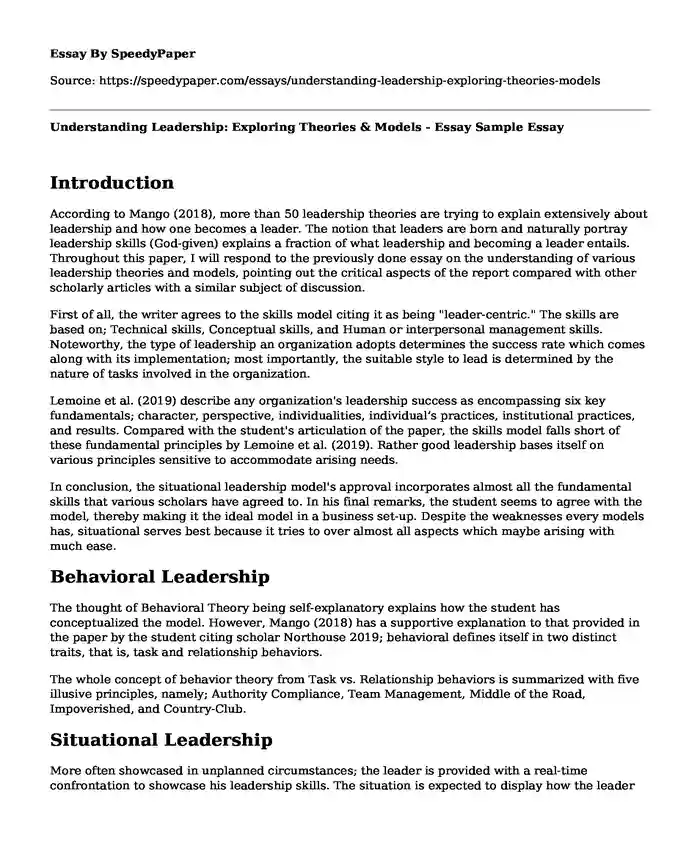
| Type of paper: | Essay |
| Categories: | Leadership analysis |
| Pages: | 3 |
| Wordcount: | 603 words |
Introduction
According to Mango (2018), more than 50 leadership theories are trying to explain extensively about leadership and how one becomes a leader. The notion that leaders are born and naturally portray leadership skills (God-given) explains a fraction of what leadership and becoming a leader entails. Throughout this paper, I will respond to the previously done essay on the understanding of various leadership theories and models, pointing out the critical aspects of the report compared with other scholarly articles with a similar subject of discussion.
First of all, the writer agrees to the skills model citing it as being "leader-centric." The skills are based on; Technical skills, Conceptual skills, and Human or interpersonal management skills. Noteworthy, the type of leadership an organization adopts determines the success rate which comes along with its implementation; most importantly, the suitable style to lead is determined by the nature of tasks involved in the organization.
Lemoine et al. (2019) describe any organization's leadership success as encompassing six key fundamentals; character, perspective, individualities, individual’s practices, institutional practices, and results. Compared with the student's articulation of the paper, the skills model falls short of these fundamental principles by Lemoine et al. (2019). Rather good leadership bases itself on various principles sensitive to accommodate arising needs.
In conclusion, the situational leadership model's approval incorporates almost all the fundamental skills that various scholars have agreed to. In his final remarks, the student seems to agree with the model, thereby making it the ideal model in a business set-up. Despite the weaknesses every models has, situational serves best because it tries to over almost all aspects which maybe arising with much ease.
Behavioral Leadership
The thought of Behavioral Theory being self-explanatory explains how the student has conceptualized the model. However, Mango (2018) has a supportive explanation to that provided in the paper by the student citing scholar Northouse 2019; behavioral defines itself in two distinct traits, that is, task and relationship behaviors.
The whole concept of behavior theory from Task vs. Relationship behaviors is summarized with five illusive principles, namely; Authority Compliance, Team Management, Middle of the Road, Impoverished, and Country-Club.
Situational Leadership
More often showcased in unplanned circumstances; the leader is provided with a real-time confrontation to showcase his leadership skills. The situation is expected to display how the leader reacts, behaves, decides, and the extent of their power to lead in any case. To achieve all these, there is a need for them to display the highest level of competence and commitment to those being lead. This style of Leadership is perceived as the best since the authenticity of the leader is revealed.
Behavioral and Situational Leadership Together
A combination of both leadership styles results in a more remarkable outcome. Every type has a weakness which will be easily overwhelmed by other style’s strength; the symbiotic relationship always produces the best from the ordinary. Where situational Leadership becomes static and monolithic, behavioral approach chips in. the example from the bible provides an illustration of a combined leadership skills that is, in the book of 1st and 2nd kings, the Lord sends Shemaiah to take his word to Rehoboam eventually stopping a war by returning to their homes. Although, the situational leadership is seen as an ideal model, it has some weakness which include; failure to account for its diversity and dynamism thus termed as being rigid and static.
References
Lemoine, G. J., Hartnell, C. A., & Leroy, H. (2019). Taking stock of moral approaches to leadership: An integrative review of ethical, authentic, and servant leadership. Academy of Management Annals, 13(1), 148-187.
Mango, E. (2018). Rethinking leadership theories. Open Journal of Leadership, 7(01), 57.
Cite this page
Understanding Leadership: Exploring Theories & Models - Essay Sample. (2023, Nov 30). Retrieved from https://speedypaper.net/essays/understanding-leadership-exploring-theories-models
Request Removal
If you are the original author of this essay and no longer wish to have it published on the SpeedyPaper website, please click below to request its removal:
- Free Essay Containing a Personal Leadership Development Plan
- Distributed Leadership and Organizational Change Essay Sample
- Homer Hickman's Heroic Journey, Conflicts and Obstacles. Paper Example
- Essay Sample on Jesus Christ's Communication Strategies
- Essay Sample on Home Depot Company Overview
- Paper Example. Qualities and Skills of Management Consultants
- Speech of Tribute to Boss on the Retirement - Essay Example
Popular categories




